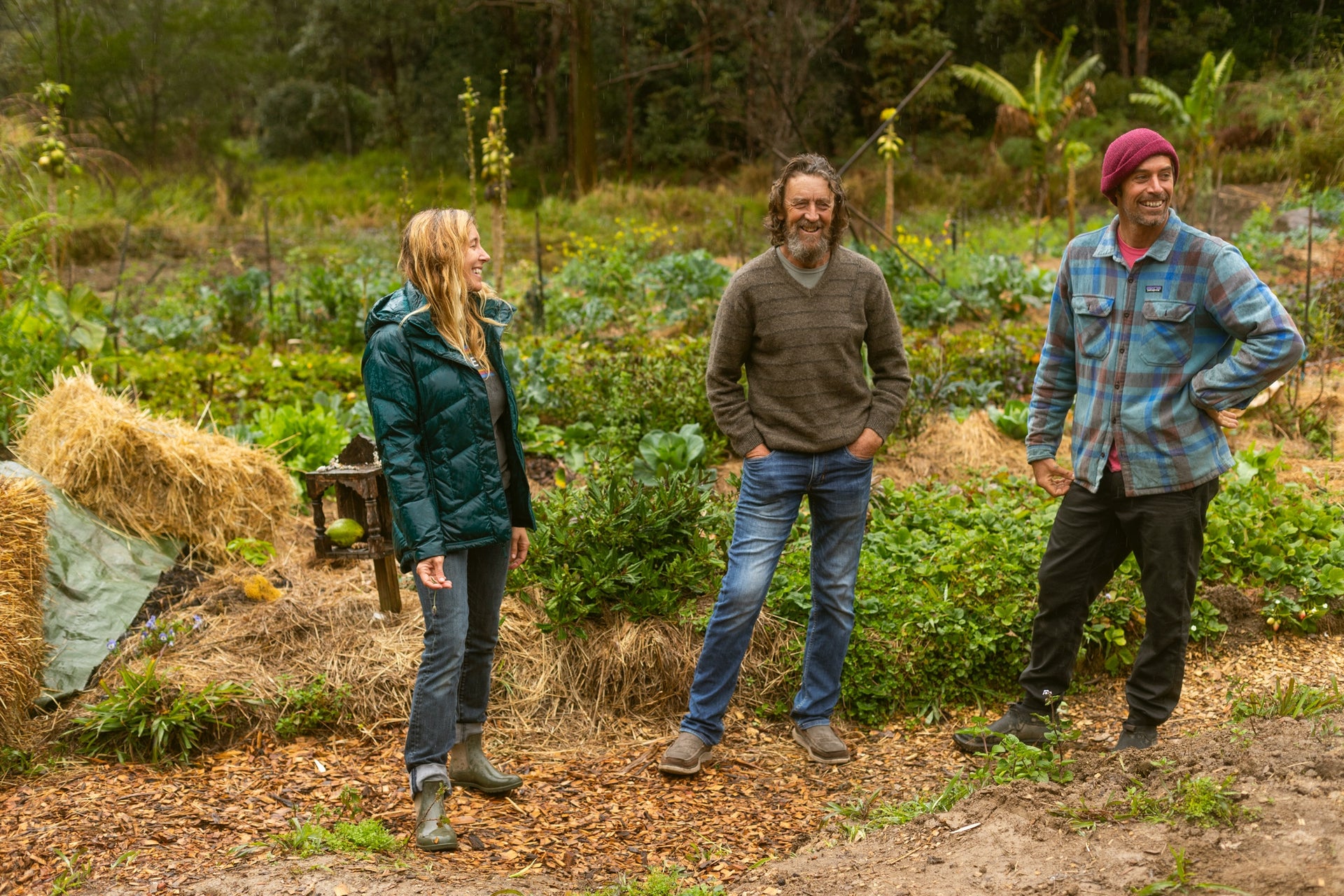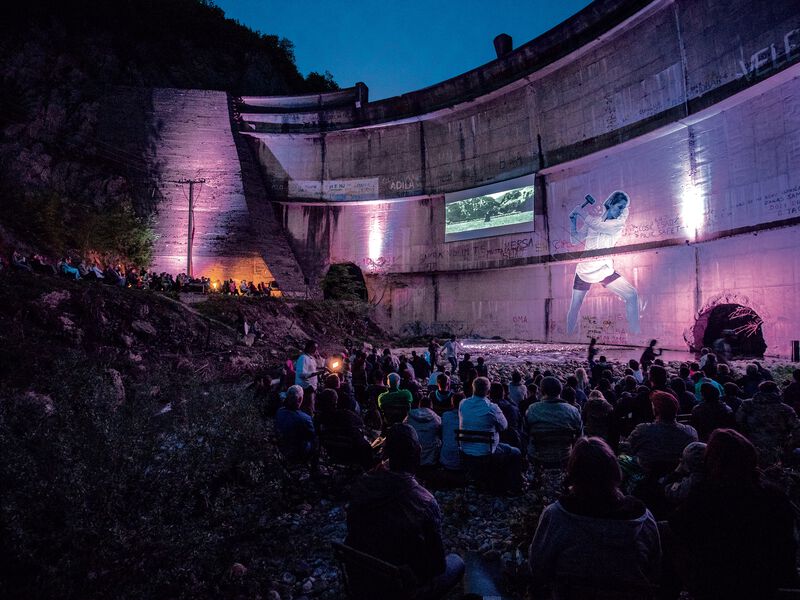I have cold, bare feet and happy red cheeks. My hands are sticky with dark, rich volcanic soil. I am four years old and sneakily eating a little of that soil while wide-eyed and pulling up odd-shaped carrots, struggling to carry heavy pumpkins, and marvelling at the tall corn that sways in the cold breeze above me.
Growing up on the wild west coast of Aotearoa felt a world away from the high rises and suburbs of the wild-in-a-very-different-way Gold Coast of Queensland. We moved when I was five, and even though the sun-bleached suburbs were the backdrop for the rest of my childhood and young adulthood, I never could forget the joy and sense of belonging I felt during those formative years in New Zealand. I now think of it as akin to a biological urge — to return to converse with the land.
Once in Oz, the ocean replaced the food garden for me. Bodysurfing, swimming, paddling and surfing became central to life. We no longer grew food, but I felt like the seeds for growing had been planted in me. They were simply soaking under the surface of my new obsession for the ocean. Someday, between waves, the light of my attention would help them sprout to the surface.
My first encounter with permaculture happened by chance when I was 15. I was staying with family friends on their five-hundred-acre subtropical permaculture farm, not too far from where I live now. For a week, without any real guide of what to do, and no supervision, our friends left me alone and in charge of this space that housed chooks, horses, food forests and sprawling veggie gardens. At that age, all I was capable of looking after was my own interests – how to get to the beach, how to surf well and then fill my belly afterwards (some would argue not much has changed). I didn’t have a clue what to do. What if the chooks got out? Or worse, the horses? Do you have to lasso them to get them back in? Would they ever come back? What if the fruit trees shrivel up and die and I’m the one responsible for the collapse of the whole place?
 Don’t forget to breathe. Photo: Nathan Oldfield
Don’t forget to breathe. Photo: Nathan Oldfield
How wrong I was. The robust and interconnected systems that permaculture nurtured afforded me much time to sit and observe the natural magic. I picked veggies. My own mind, bred by monocultural ideas of growing, was cracked open by diverse foods not planted in rows but interspersed, and growing as companions. This time felt like a delivery — in mind and belly, back to my earliest food and garden memories from Aotearoa.
My time there was even shorter than my formative years in NZ, but it kept the growing dream alive in me. Watering the seeds. The ‘culture’ part of permaculture started to reveal itself to me then, too. I had enough time to go surfing with one of the neighbours, who happened to be legendary surf filmmaker Albe Falzon. It was the beginning of a decades-long friendship of deep appreciation for life, and a reminder of the world-shaping power of a single week. What grew in me was the understanding of balance I felt between a surfing life and a growing life, guided by the principles of permaculture.
Surfing led me around the world through my teens, twenties and part of my thirties. Exploring remote surf regions periodically kept me in touch with people growing food. Witnessing many approaches to growing, different climates and approaches to the land, opened my eyes to how easy or hard it can be. But also, I noticed what is lost in us when we urbanise and/or industrialise our food systems. When we outsource the jobs, we also outsource the opportunity for connection.
Like most surfers, I travel seasonally, following weather patterns that have us cyclically returning to the same places each year. It hasn’t been uncommon to return to surf regions to find coastal waters freshly emptied of fish and river systems so polluted you wouldn’t dare surf near them. I’ve witnessed food options in remote locations, once fresh and varied, change over to the global norm of white bread, white rice and sugar.
These first-hand experiences showed me what has now been broadly documented: our global, industrial food system is the biggest destroyer of biodiversity on the planet. It contributes one third of all greenhouse gas emissions. It has become clear to me that personal and planetary health diminishes when we industrialise our food growing. We are starved of nutrient-rich foods, yet we are more obese than ever. Most industrialised agricultural lands are estimated to hold only 50 harvests more before the land is incapable of producing high yields.
We need to change the way we grow food for each other. The great news is there are many food systems that support, replenish, and heal land and sea — and humans too.
Reciprocal approaches to growing food have long been part of healthy, thriving human culture. Life in conversation with the land actually makes up most of our food growing history. Industrialised food systems are a short and destructive diversion from our better ways. First Nations people all over the world have deep histories of living within loving limits of land management and food cultivation or collection.
In Australia, we have guiding lights like Bruce Pascoe, who corrects colonialist history and illuminates Indigenous practices of land management — which prospered for tens of thousands of years while European land practices have been destroying the Australian ecology for a couple hundred years. In the US, Robin Wall Kimmerer’s celebrated book Braiding Sweetgrass marries First Nations wisdom with the categorical observations of modern science. New iterations of regenerative food growing practices such as syntropic gardening from Brazil, which grew out of the devastated and deforested lands there, and permaculture here in Australia, are providing many with an approach to food growing that builds biodiversity and strengthens organic communities (including us) year after year.
Having the good fortune of living on land in the Northern Rivers region, my hands were straight into the soil to grow our food and replant lands logged and left to roaming cattle for decades. Our small successes with a permaculture-style kitchen garden were encouraging enough to want to expand into growing for a new child and our neighbouring friends and family. When the Covid travel restrictions came along we really got busy with this idea and had the great luck of being able to go surf and yarn with local permaculture legend, Geoff Lawton about making a personal community garden.
Along with sculpting the soil into raised beds and then feeding the soil through cover crops of vetch, cowpea and millet we also implemented Geoff’s technique of STUN planting, which stands for Strategic Total Utter Neglect. Meaning we plant heavily and diversely and then give the plants space to figure who will thrive and who will wither down and feed the soil.
Our decision to grow food gently and abundantly would not only be personal, but also political and connected to planetary health. Each time we gather food in our garden we are opting out of buying a basket of store-bought food at our local shop that has nearly 20,000 travel kilometres attached to it. Each basket of vibrant mineral-rich greens, purple earthy sweet potatoes, blazing chillies and bright fragrant herbs from our garden is a gift from Mother Nature and so we gift it on also by keeping money out of the equation. We trade produce, or people volunteer time and energy or we simply give the surplus away. Each basket we fill is free from chemical inputs.
When the fragility of our global food system was exposed at the height of the pandemic and some food items became scarce, we were gifting boxes of greens, herbs, and root vegetables to friends who were working overtime and unable to have a garden space of their own. When the recent Northern Rivers floods washed people out of their homes, surplus from our garden went to feeding displaced locals.
Equal to the fulfilment of having a direct relationship to the food we ingest has been the enrichment of our human relationships. We move our bodies in the garden and deep emotions seem to release. There is a letting go of stress and tension. This has been needed more than ever for most of us who have endured isolation, illness, fires and floods. The joy of picking and eating rich red strawberries or crunchy fresh snow peas creates joyful connective moments together that are not to be underestimated.
Reliving the connectedness I felt as a growing four-year-old in New Zealand feels like the moment when you draw a circle and the two ends meet to make it whole. I knew I wanted my own child to also have a foundational experience of where food comes from, to marvel at the magic of how Mother Nature can grow a blazing hot chilli, a creamy banana and a juicy lychee all with the same elements of light, water and soil. I knew I would find the joy of belonging to a garden again and that I would be lost in that joy.
 Beyond the abundance of healthy produce the garden has social benefits, bringing neighbours together and connecting them to the soil. Photo: Nathan Oldfield
Beyond the abundance of healthy produce the garden has social benefits, bringing neighbours together and connecting them to the soil. Photo: Nathan Oldfield
What I didn’t anticipate was how this would enrich my social life and connection to my local human community. So many great moments of deep conversation and connection have happened while working shoulder-to-shoulder with people in the garden. In fact many men, who typically find it uncomfortable to open up and speak of emotions or vulnerabilities will often chat in the garden about things they would never speak of if we were sitting face-to-face over a cuppa tea or to simply ‘have a chat’. I didn’t know that our little growing space would immediately be needed in response to struggling global food systems, and that we could help locals during climate change catastrophe. I also didn’t expect the garden to help my mental health when surfing locally was dangerous due to our beaches being polluted after the floods. But all these surprises have been deep and meaningful.
The great Australian farmer and author Charles Massey says regenerative farmers need an “emergent mind” that lets go of the need to control all outcomes within a landscape. There is a level of unknowability when living reciprocally with Country… almost like when we paddle out into the line-up to surf, we trust that waves will come and hopefully we will be there, observing patterns while in the right place and in the right state of being to fully participate.







Dave is an aquatic mammal who has adapted to life on land. He is a surfer, gardener, activist and father, who has become one of surfing’s leading voices for the natural world. He was born on Aotearoa and lives today on Bundjalung Country.